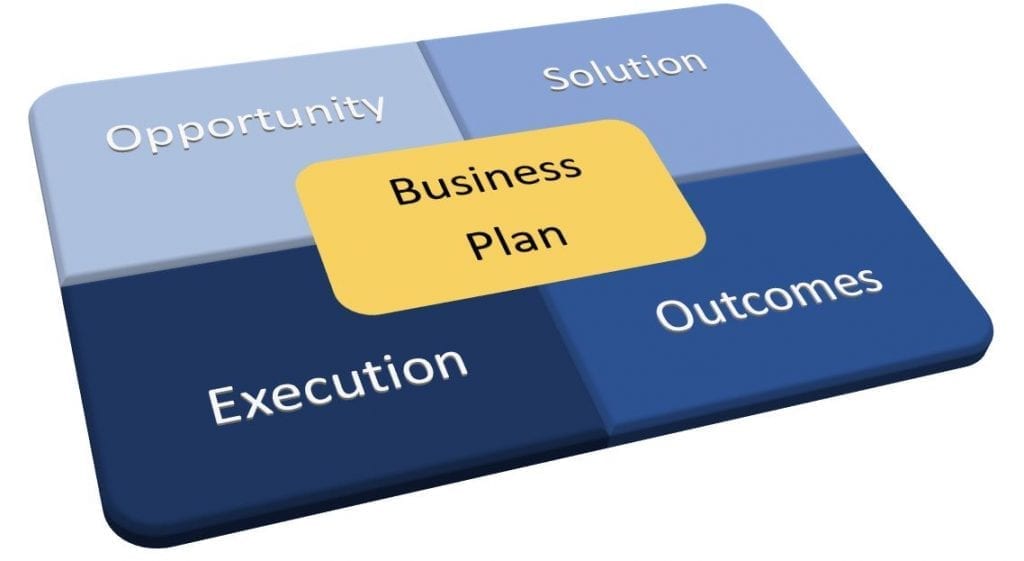The Four Cornerstones of Every Business Plan
The prospect of preparing a business plan for the first time can be very daunting. There are many “moving parts,” and it’s easy to get lost in the details.
The task becomes much easier if you think of your plan in terms of four essential cornerstones that serve as the foundation of all business plans: Opportunity, Solution, Execution, and Outcomes.
Contents
The Four Types of Business Plan Content
Almost everything that belongs in a business plan falls into one of four categories:
Cornerstone 1: Opportunity
Every successful business exploits an opportunity. Opportunities arise from “problems” that customers are willing to spend money to solve: they want to stay in touch with friends (Facebook and Twitter); they want to eat a tasty Italian meal (Olive Garden and Macaroni Grill); they want to manage their enterprise data better (Oracle and SAS); they want to commute to work in a fun but fuel-efficient vehicle (Tesla and MINI Cooper); they want to get and stay fit and trim (LA Fitness and Peloton). The Opportunity portion of your business plan delves into the nature of the problem: who experiences the pain; the severity of the pain; the trends affecting the source of pain; how people are currently addressing the pain (both substitutes and competitors); and how much people are willing to spend to alleviate the pain. Broadly speaking, the Opportunity is a description and analysis of your potential market.
Cornerstone 2: Solution
This is your brilliant idea. Exactly what are you introducing into the marketplace that takes advantage of the opportunity you’ve identified? How does it work, and how does it solve the problem? What are the features and benefits? How will you price it and position it in the market? Have you patented it? How does it stack up against competing solutions to the problem? How will you stay ahead of the competition?
Many first-time entrepreneurs make the mistake of thinking their idea is the essential ingredient in building a successful business. While your solution is a cornerstone, and you should fully address all the questions we’ve stated in this section, you have three other areas to address that matter just as much as this one.
Cornerstone 3: Execution
Execution — the difficult task of turning ideas into products that people will buy — is what separates successful entrepreneurs from dreamers. What is your plan for completing the development of your product and getting it ready to market? How will you generate awareness and close sales? How do you manufacture and distribute it efficiently? What kind of facilities will you need? What type of management team will your company require? What does the product cost to manufacture? How will you make money? How will you overcome the regulatory hurdles? What types of business partnerships will you need to forge? What could go wrong, and what can you do to mitigate the risks? How will you carve out a profitable niche and keep competitors at bay? What kinds of variable and fixed expenses will you incur to make this happen? How much investment capital will you need to pull this off?
Cornerstone 4: Outcomes
This is your vision of the future outcomes if things go according to plan. How much of your product do you expect to sell each year over each of the next five years? How do you justify this expectation? How will the inevitable changes in markets, consumer behaviors, and competitive offerings affect outcomes? How much cash and profit will your company generate? What will your balance sheet look like in five years? Can you get there without running out of funds? If your company becomes successful, what are the viable ways for your investors to cash out?
Put the Four Cornerstones to Action
Use these cornerstones to organize your thoughts.
When you sit down to start working on a business plan, grab four blank sheets of paper and write the words Opportunity, Solution, Execution, and Outcomes across the top.
Now, start brainstorming. Get as many ideas down as possible. Don’t worry about structuring things into a business plan yet. If one of your sheets looks empty compared to the others, then you have more work to do.
When you have finished, set these sheets of paper aside for a few days and don’t think about them. When you’re ready, go back and look for a powerful, compelling storyline that links the four sheets together. Next, go through each sheet and cross off the items that don’t support the storyline. Look for and eliminate mistakes commonly found in business plans.
A business plan, regardless of your target audience, is essentially a narrative that ties these four cornerstones together. Thus, by going through this simple process, you’ve halfway to having a well-conceived first draft of your business plan!

